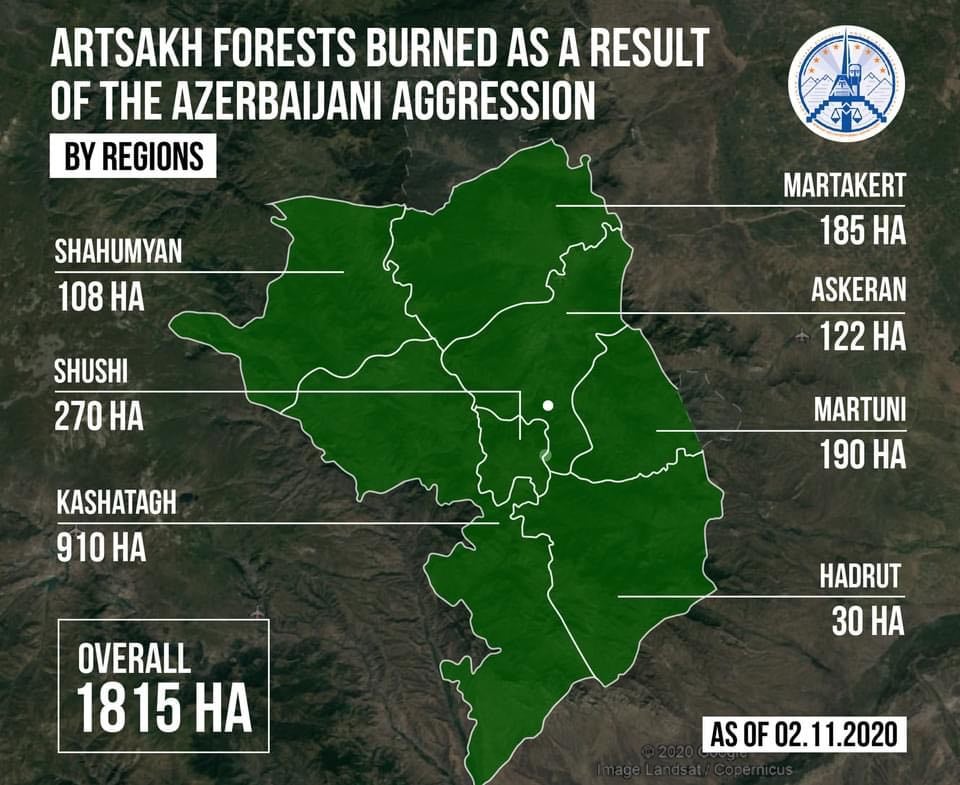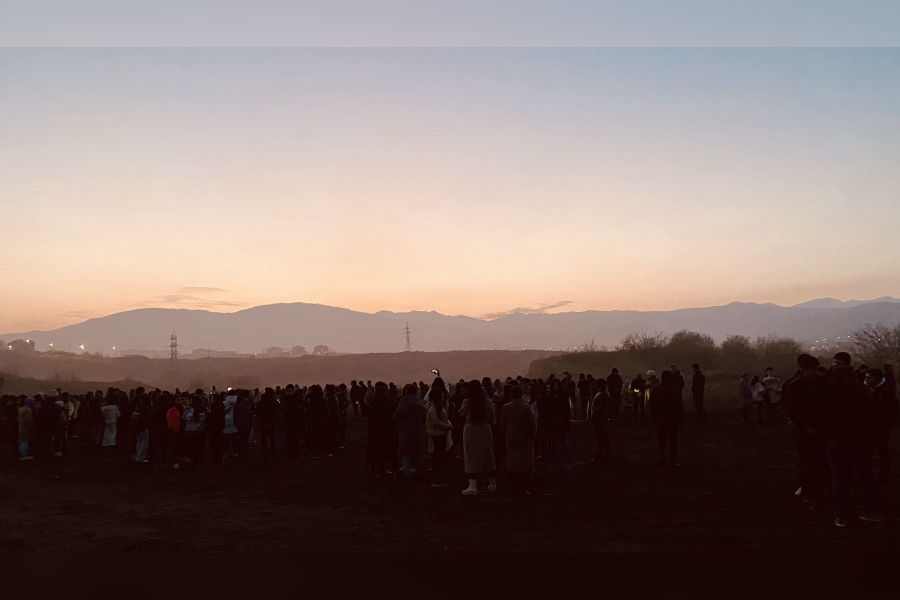Armenian Environmental Organizations Raise Alarm about Use of White Phosphorus in Artsakh’s Forested Regions

 YEREVAN—On Sept. 27, a full-blown war erupted between Artsakh (Nagorno-Karabakh) and Azerbaijan in the South Caucasus. The war, which has already taken the lives of thousands of soldiers in a few short weeks, presents a serious threat for the biodiversity of the region.
YEREVAN—On Sept. 27, a full-blown war erupted between Artsakh (Nagorno-Karabakh) and Azerbaijan in the South Caucasus. The war, which has already taken the lives of thousands of soldiers in a few short weeks, presents a serious threat for the biodiversity of the region.
Armenia and Artsakh are known for their primeval forests, which are among the most biodiverse forests in the region. Considered one of the world’s hotspots in terms of biodiversity, the region is home to more than 6,000 plant species, 153 species of mammals and 400 species of birds. Hundreds of plant and animal species in Artsakh are also listed in the International Union for Conservation of Nature (IUCN) Red List of Threatened Species.
As video evidence shows, on October 30, white phosphorus munitions were deployed as a chemical weapon over the primeval forests of Artsakh in an attempt to burn down forests where civilians are taking shelter. The use of chemical weapons is internationally recognized as a war crime and its effects on the environment are devastating.
Fifty-two Armenian environmental organizations have released a statement (included below) calling on the international environmental community to take actions now to prevent a devastating regional ecocide.
The statement highlights that white phosphorus munitions directly threaten the existence of any life in the area and the habitats of endangered species of the region, such as the brown bear, Bezoar Goat, Armenian Mouflons, Eurasian Lynx, vultures, eagles and the globally threatened Caucasian Leopard* of which only 1,000 exist in the wild.
The Caucasian Leopard is at high risk of extinction in the region. Armenia, Artsakh, Iran and Azerbaijan have invested significant resources to conserve the flagship species, which is the last biggest feline left in Europe.
In their statement, the groups emphasize that white phosphorus munitions also accumulate in soil and rivers, contaminating groundwater and threatening all the people and wildlife living in the wider region. The use of phosphorus munitions contradicts the provisions of major environmental conventions such as the Bern Convention, the Nagoya protocol, as well as the Helsinki and Rotterdam conventions, signed by both Armenia and Azerbaijan.
The groups call on the global conservation community to raise awareness about the potential for an environmental disaster in Artsakh and the greater region and condemn the use of phosphorus munitions in the current war.
*The Caucasian Leopard is recorded in Artsakh’s Red Data List and IUCN Red list as Critically Endangered.

Subject: Ecocide Alert in Nagorno–Karabakh region amidst war between Armenia and Azerbaijan
Dear Partner,
As you may be aware, on September 27th, 2020, full–blown war exploded between Armenia and Azerbaijan over Nagorno-Karabakh (Artsakh) with four ceasefire regimes negotiated under the umbrella of Minsk OSCE Group, violated during October, 2020.
During this large-scale war, the most intensive since the 1994 ceasefire agreement in the Southern Caucasus region, a number of war crimes were mounted and documented, among them beheadings of Armenian soldiers, killing of civilians in a city square wrapped in Armenian flags, deliberate attacks on civilian infrastructures – residential buildings, churches, food markets, schools and maternity hospitals.
On October 30, 2020, the environmental community of Armenia, including local, regional and international environmental organizations, conservation pioneers, scientists and non-governmental organizations, was shocked to witness another disastrous war crime against natural ecosystems and crucial livelihoods of Artsakh.
As per credible reports and collected data, comprised by Human’s Right Defender of Armenia, Azerbaijani military forces have used white phosphorus munitions containing elements of chemical weapons in the primary forests of Artsakh, which is a gross violation of International Humanitarian Law, principles of Customary Law, Geneva Convention, Chemical Weapons Convention, Convention on the Prohibition of Military or Any Other Hostile Use of Environmental Modification Technique, as well as the provisions of the relevant UN conventions and documents. As video evidence shows, these weapons are being used in an attempt to burn down forests where-civilians are taking shelter from Azerbaijan’s attacks.
The ongoing large-scale war seriously threatens the biodiversity of the region, which has been recognized as one of the world’s biodiversity hotspots. This region is well-known for its high rate of endemism and for being home to more than 6000 plant species, 153 species of mammals, 400 species of birds and other living organisms. Hundreds of plant and animal species found in Artsakh are listed both in the local Red Book and the IUCN Red List of Threatened Species having a protection status at a global level.
Among them are the critically endangered Persian (Caucasian) Leopard, known to migrate through Mrav ridge of Armenia and Artsakh towards the Iranian border, as well as to Azerbaijan and vice versa, which is a rare species with declining numbers protected at a regional and global level.
Furthermore, Armenia and Artsakh are known for their primary forests, which are amongst the most biodiverse forests in the region. Not only do these forests play a major role in preserving favorable environmental conditions for sustainable development, but local people are heavily dependent on these forests for their livelihoods. Traditional forest-related knowledge accumulated over thousands of years is deeply linked with the cultures of indigenous people living in Artsakh.
The usage of white phosphorus munitions by Azerbaijani forces in those forests will not only destroy valuable ecosystems and habitats and put threatened species at the risk of extinction, but will contaminate rivers and underground waters for years, thus turning into a major threat of regional scale for all the people and wildlife living in the region.
We are therefore calling out to the global conservation community for support to help stop the usage of white phosphorus munitions before they cause an environmental disaster and regional ecocide.
The usage of white phosphorus munitions contradicts to all the provisions of all environmental conventions including the Bern Convention, Nagoya protocol to Helsinki and Rotterdam conventions, verified by the governments of both Armenia and Azerbaijan
Although 98% of the global population live under the protection of the Chemical Weapons Convention, this is, as we understand, unfortunately not applicable towards Armenia and ethnic Armenians living in Artsakh.
Ongoing developments continue to threaten any form of life in the region and thus we’re addressing you, as a leading environmental organization in the field, to:
- Write to appropriate contacts and conservation partners in your network to express your concern of the possible environmental destruction in Artsakh and the region
- Raise awareness within your networks/social channels
- Condemn the actions of any military force that uses white phosphorus munitions in forests and habitats destroying crucial ecosystems and therefore forbidden under international law
- Call for responsibility to protect valuable ecosystems, species populations and genetic resources from ecocide in Artsakh
- Call for moral responsibility in a time of war and exclude war crimes both against humans and nature.
Please kindly inform us, the undersigned, about actions undertaken by your organization advocating for sustainable development and environmental resilience, and further steps aimed at eliminating the risk of the ecocide in Artsakh region, which is a crucial habitat to threatened species and populations not recognizing political borders and/or regional disputes.
Yours sincerely,
- Foundation for the Preservation of Wildlife & Cultural Assets (FPWC)
- Armenian Society of Biologists NGO
- Eco Waste Environmental NGO
- Yerevan Aarhus Center
- Armenia Tree Project (ATP)
- Sunchild NGO
- Strategic Development Agency
- Solution Hub NGO
- Green Age NGO
- American University of Armenia/Harutyun Alpetyan, Waste Governance Expert
- Environmental Public Society
- BlEJAN, environmental, social, business support NGO
- Araves Bird conservation NGO
- Armenian Environmental Front
- BEM Youth progressive Action Center
- Freedom of Information Center of Armenia
- Institute of Botany after A.Takhtajyan NAS RA
- World Independent Youth Union
- Doctor Cinema Youth NGO
- Amities Luxembourg – Armenie a.s.b.l,
- Formation et Sensibilisation de Luxembourg
- Regional Development and Research Center NGO
- “Econews.am” environmental informative website
- Public Awareness and Monitoring Centre’ NGO
- Dingo Team NGO
- SALU (Sensibilité et Attention Luxembourg)
- Caucasus Wildlife Tours
- Armenian Environmental Network
- Lab Inclusion (France
- Green Armenia Environmental Education NGO
- White Squad Environmental NGO
- “Armenian Botanical Society” NGO
- SwIdeas AB (Sweden
- 500 km in Armenia
- Sunchild Eco – tours
- BLESK LLC env. assessment org./Armenian Branch
- “Dalma-Sona” Foundation
- University of Traditional Medicine, Armenia
- Armenian Women for Health & Healthy Environment NGO
- One Health Coalition
- “EcoLur” informational NGO
- Clean Goris NGO
- Country Water Partnership NGO
- Sustainable Water Environment NGO
- “Centre for Community Mobilization and Support” NGO
- Green Lane NGO
- “Consumers’ Consulting Center” NGO
- My Forest Armenia NGO
- “Support of Botanical Garden” Charity Foundation
- Armenian Forests Environmental NGO
- ARK Armenia Environmental NGO
- Time Land Foundation










I first learned of white phosphorous when Amy Goodman interviewed Norman Finkelstein. He noted that Israel’s use of white phosphorous against Palestinians is an example of why US Jews won’t support Israel.